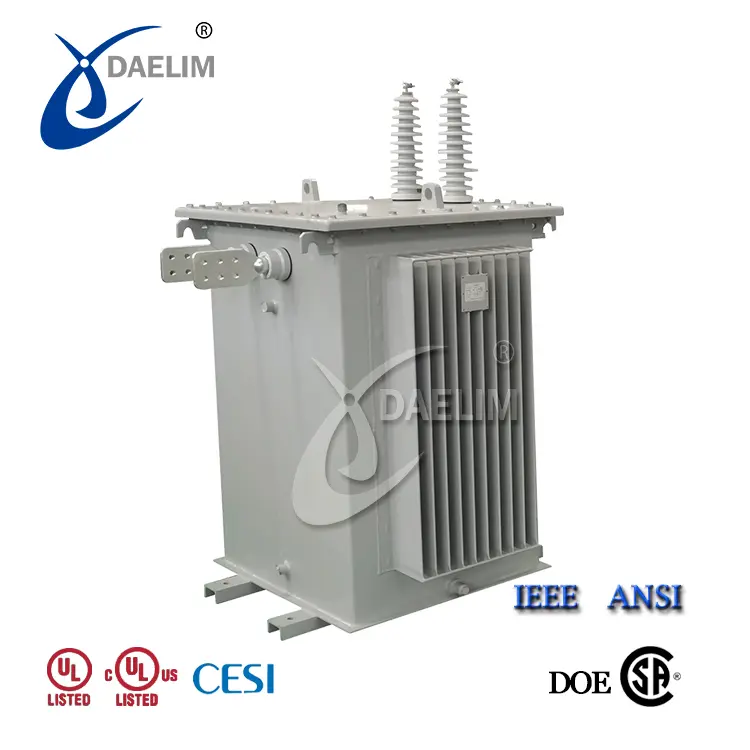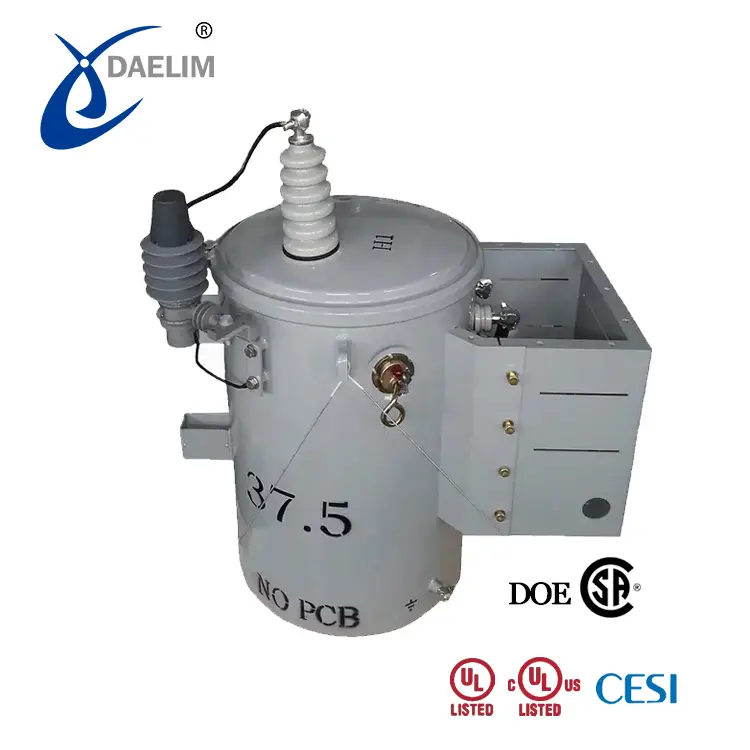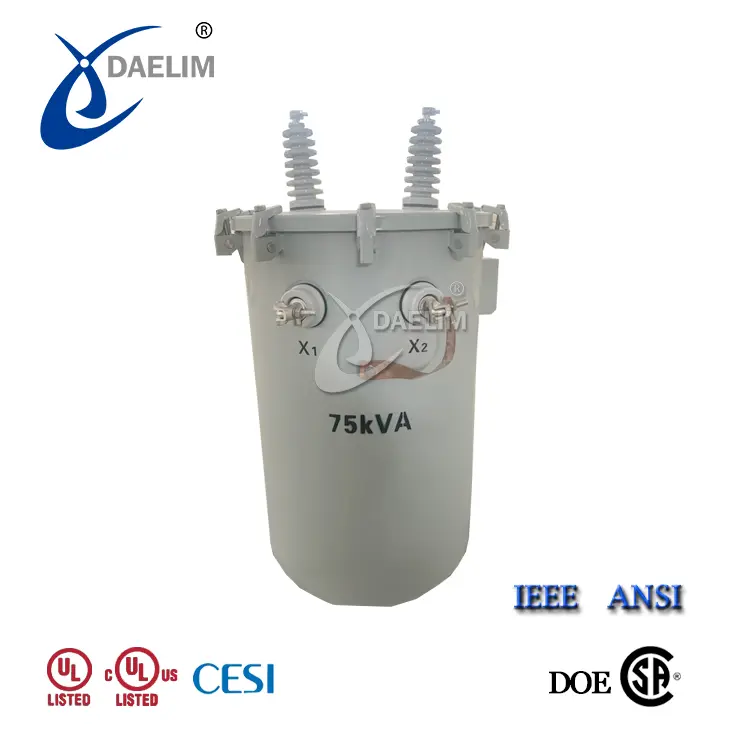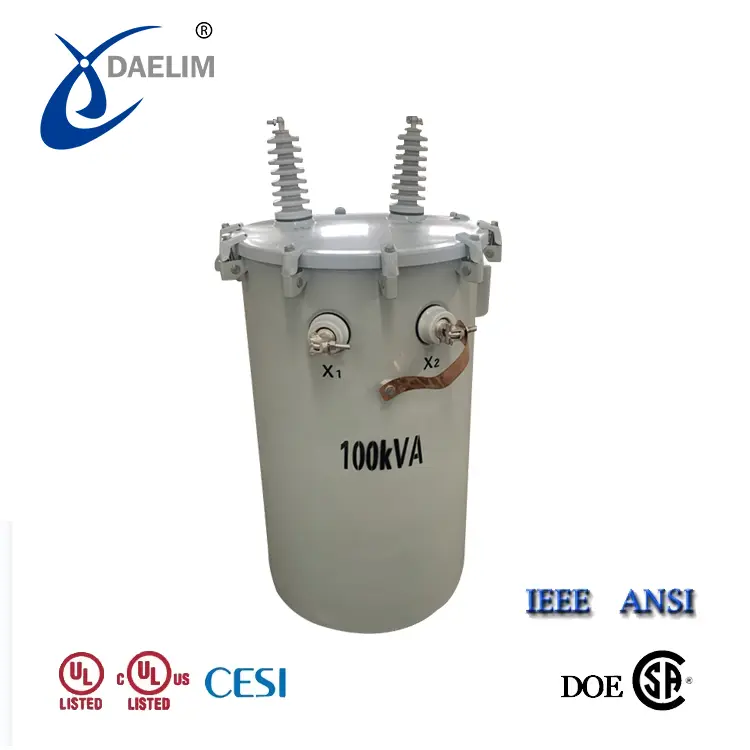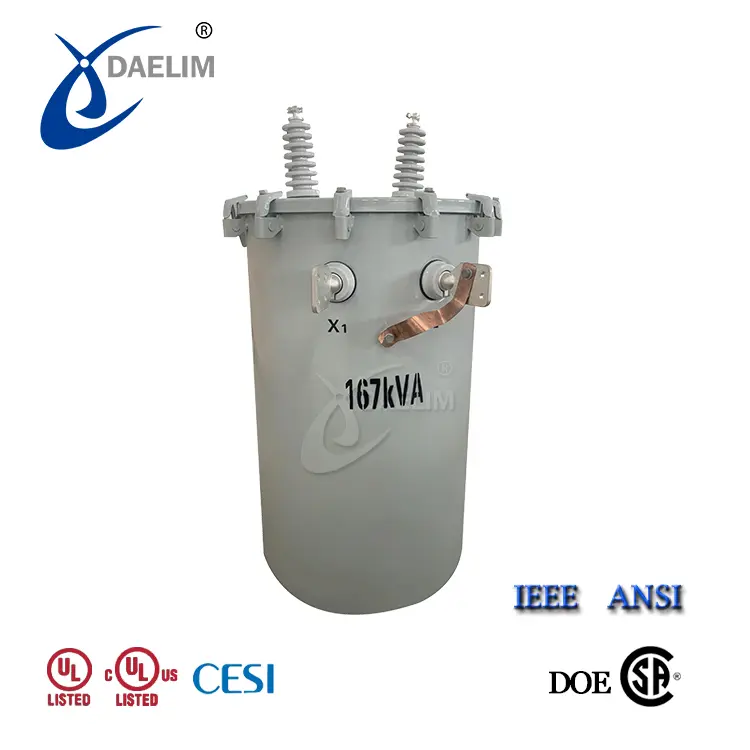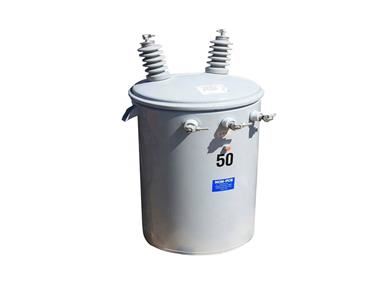What You Need To Know About Overhead Transformers
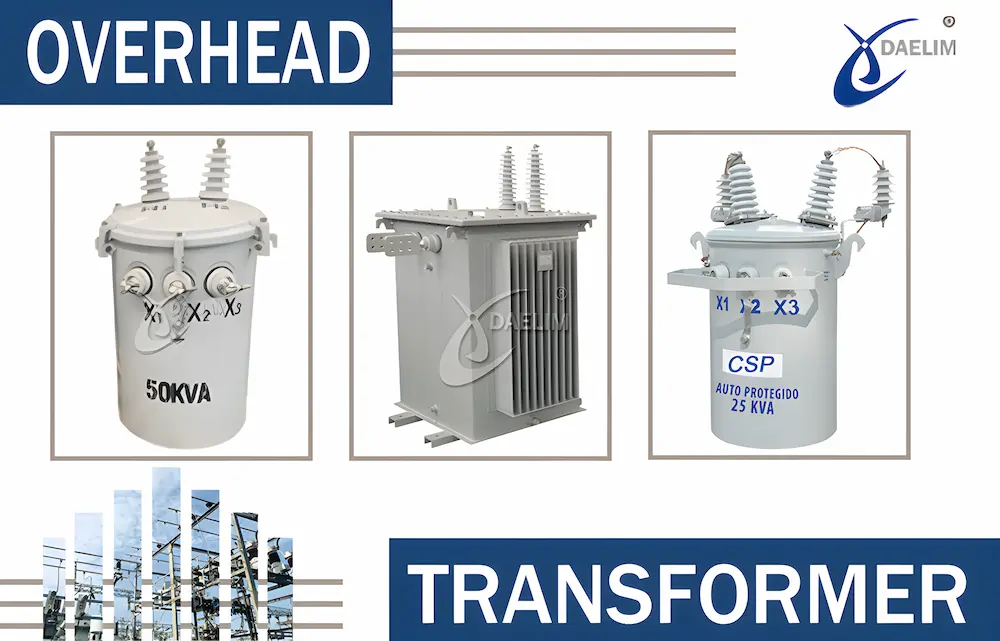
The purpose of overhead distribution transformers is to facilitate the distribution of loads to homes. These transformers can be categorized as single-phase overhead transformers or three-phase overhead transformers.
Daelim Belefic specializes in offering high-quality single-phase overhead distribution transformers. You can rest assured that the overhead transformer connections and configurations they provide are always efficient.
Contact Daelim TransformerWhat Is An Overhead Distribution Transformer?
Overhead distribution transformer are one of the vast majority of distribution transformers manufactured today. It is common knowledge among certain locals that these are pole-mounted transformers. Overhead distribution transformer can be mainly found in a broad variety of sizes and configurations.
What Are The Applications Of An Overhead Distribution Transformer?

Overhead distribution transformer are always put in place to convert the high voltage of energy that is basically provided by power lines into a more manageable level for use in buildings.
At the same time, overhead distribution transformers are the ones responsible for supplying housing connections.
- Residential settings
- Light industrial loads
- Commercial lighting
- Roadways
- Railways
Try for free: CSP VS Conventional Transformer: Which Is Better?
What's Inside An Overhead Distribution Transformer?
The most fundamental part of an overhead distribution transformer is the core and coil assembly.
To reduce the distribution voltage to safe levels for consumers, only the transformer core and coil assembly are necessary.
Any other components are essentially add-ons meant to boost its usefulness or strengthen its safety.
The core and coil set are generally housed in a cylindrical steel tank filled with high-grade mineral oil that has been highly refined for electrical usage.
This oil has a dual purpose: first, it keeps the windings at a reasonable temperature, and second, it prevents electrical contact between them.
In addition to mineral oil, Daelim transformers can also use environmentally friendly vegetable oil with ul certification.
Reading more Distribution Transformer
What Is A Single Phase Overhead Transformer?
 A single-phase overhead transformer is a type of transformer that is typically used in power distribution systems to convert high voltage power into low voltage power for use in residential, commercial, and industrial settings.
A single-phase overhead transformer is a type of transformer that is typically used in power distribution systems to convert high voltage power into low voltage power for use in residential, commercial, and industrial settings.
This type of transformer is called "overhead" because it is mounted on a pole or other elevated structure above the ground. It has a single-phase configuration, which means it has one primary winding and one secondary winding.
The primary winding is connected to the high voltage power source, while the secondary winding is connected to the low voltage power lines that distribute power to homes, businesses, and other facilities.
Single phase overhead transformers are commonly used in areas where power demand is low or moderate, such as residential neighborhoods, small commercial areas, and rural locations. They are often smaller and less expensive than three-phase transformers, which are used in larger commercial and industrial applications.
Get it now: 50 kVA Transformer, Get the Best Price
What Are The Standard Ratings of a Single Phase Overhead Transformer?
The standard rating of a single phase overhead transformer depends on the needs of the specific application and the electrical system it will be connected to. However, because the single-phase overhead transformer in the power distribution system is installed on the utility pole, there are some restrictions on volume and weight. So it has some common standard ratings. These include:
Voltage: The primary voltage of single phase overhead transformers ranges from 2400V-34500V. Secondary voltages are typically between 120 and 240 volts (V) for residential applications and may be higher for commercial or industrial applications, 240-480V, 347V, and 600V.
Power Rating: Single-phase overhead transformers are usually rated in kilovolt-amperes (kVA) and range from 5kVA-167kVA. This rating represents the maximum power the transformer can deliver to the load.
Frequency: The frequency of single-phase overhead transformers is typically 60 Hz in North America and 50 Hz in some other parts of the world.
Other factors that can affect the rating of a single phase overhead transformer include ambient temperature, altitude and the type of load it will be connected to. Therefore, before purchasing a sinle phase overhead transformer, the rating of the transformer should be carefully confirmed with the transformer supplier to ensure its safe and reliable operation in the electrical system.
Reading more about Transformer Standard
What Are The Standard Characteristics Of A Single Phase Overhead Transformer?
These are the common features you can see in a single phase overhead transformer
- Lifting hooks
- Cover with an eyebolt attachment and a porcelain bushing
- Low-voltage grounding strap
- Tank ground components are basically separated from active components and insulated for enhanced resistance to corrosion.
- The re-sealable and self-venting cover assembly
- Bolt-in pads for the core and coil are set at an angle of 180 degrees from one another.
- Overload reset and indicator lights are generally built into the secondary breaker's control knob.
- Tank's bottom rim is generally constructed with three layers.
How Does Daelim Perform Testing For Single Phase Overhead Distribution Transformers?
Daelim does extensive testing on its single phase overhead distribution transformers to ensure they meet the requirements of the most recent ANSI, IEEE,NEMA, CSA revision.
Routine Test
A single phase overhead distribution transformers is generally put through rigorous testing at the manufacturer to ensure it is well-constructed, can resist the circumstances it will face in service, and can handle its rated load.
Daelim meticulously tests every single one of their single phase overhead distribution transformers before release.
- Leak test
- Polarity and phase relation
- Resistance
- No-load loss and excitation current
- Load loss and impedance
- Applied voltage
- Induced voltage
- Full wave impulse
- Ratio test
The above are conventional transformer tests. If you need some special experimental items, Daelim can also meet them.
Try for free: How to test a power transformer?
What Are The Advantages and Disadvantages Of Overhead Distribution Transformer?
Here are some of the benefits and drawbacks of using an overhead distribution transformer.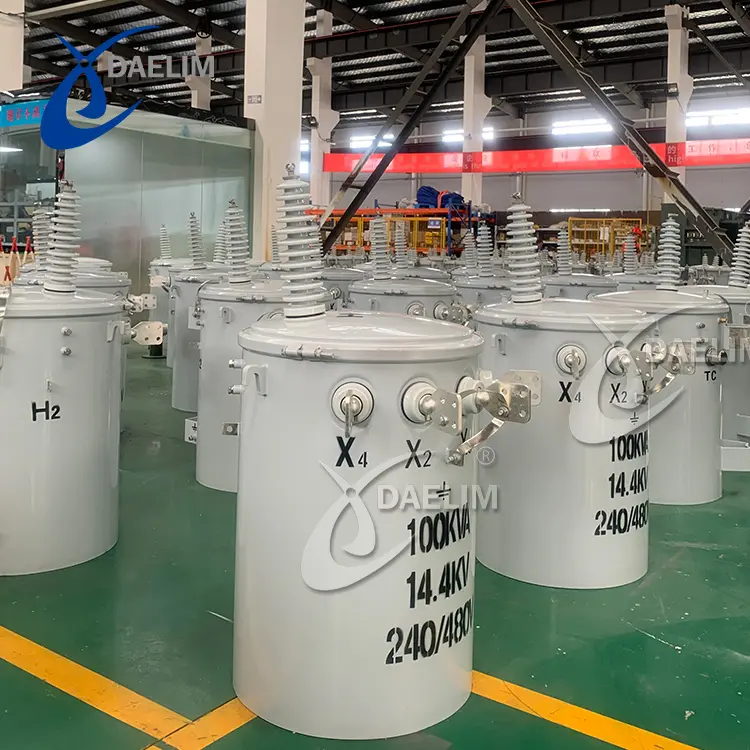
Advantages
- Large amounts of energy are highly transferred.
- Easy preparation and storage with little initial investment.
- Long-distance transmission.
- When an issue occurs with the wires above ground, it's easy to find the source.
- The line is less complicated to keep up.
- Connections, extensions, and replacements of overhead cables are all quite simple tasks.
- Saves energy and prevents blackouts caused by low-side spikes.
- When compared with other forms of protection, spark gaps are remarkably cheap.
Disadvantages
- Because of its porous design, it poses a significant security risk.
- Throughout the line's path, there must be periodic breaks.
- A target for lightning strikes
What Is A 3 Phase Overhead Transformer?
 A 3 phase overhead transformer is a type of transformer used in three-phase electrical power systems, which are commonly used for power distribution in commercial, industrial, and residential settings. These transformers are designed to convert high voltage, low current power from the transmission lines to low voltage, high current power that can be used by homes and businesses.
A 3 phase overhead transformer is a type of transformer used in three-phase electrical power systems, which are commonly used for power distribution in commercial, industrial, and residential settings. These transformers are designed to convert high voltage, low current power from the transmission lines to low voltage, high current power that can be used by homes and businesses.
The basic construction of a 3 phase overhead transformer is similar to that of a single-phase overhead transformer, but it has three separate primary windings and three separate secondary windings, each wound around a common magnetic core. The three primary windings are connected to the three-phase power supply, while the three secondary windings are connected to the three-phase load.
3 phase overhead transformers are available in a wide range of ratings and configurations to meet the specific requirements of different electrical systems. They are typically rated based on their maximum power output, primary and secondary voltage levels, and frequency. These transformers are used in a variety of applications, including power distribution for residential, commercial, and industrial customers, as well as for industrial equipment and machinery.
Learn more about Three Phase Transformer
What Are The Standard Ratings of A 3-Phase Overhead Transformer?
Some common standard ratings for three-phase overhead transformers include:
Power output: 5 kVA, 10 kVA, 25 kVA, 50 kVA, 75 kVA, 100 kVA, 167 kVA, 250 kVA, 315 kVA.
Primary voltage: 7.2kV, 7.6kV, 7.9kV, 11kV, 14.4kV, 19.9kV, 22kV, 24.9kV, 33kV, 34.5kV, etc.
Secondary voltage: 220 V, 240 V, 415 V, 480 V, 600 V.
Frequency: 50 Hz or 60 Hz, depending on region and electrical system.
The specific rating of a three-phase overhead transformer depends on the requirements of the electrical system in which it will be used. Transformers are usually designed and manufactured to meet the specific voltage and power requirements of the grid and also need to comply with various standards and regulations in the region. For example, transformers used in Canada must comply with CSA standards.
What Are The Standard Features Of A 3 Phase Overhead Transformer?
3 phase overhead transformer typically consists of the following components:
- Utilizing a coiled core is a great way to boost performance.
- Coils benefit greatly from the insulated paper since this increases their short-circuit resistance, efficiency, and thermal stability.
- Due to the three-point bracing system, the mechanical strength is highly increased.
- A pressure relief valve is usually integrated into the resealable, self-venting lid.
- Provides more protection because of increased tank resistance.
What Is The Difference Between Single Phase Overhead Transformer And 3 Phase Overhead Transformer?
The main difference between single phase and 3 phase overhead transformers is the number of phases they use to transmit electrical power.
A single phase overhead transformer uses a single phase of alternating current, typically with a voltage of 120V or 240V, to supply power to residential and small commercial applications. This type of transformer is commonly used in rural areas where there is low demand for electricity.
On the other hand, a 3 phase overhead transformer uses three phases of alternating current, each phase offset by 120 degrees, to transmit electrical power. This type of transformer is typically used for industrial and commercial applications, where there is a high demand for electricity.
3 phase transformers can handle much higher power loads than single phase transformers, and are more efficient and economical for transmitting large amounts of electrical power over long distances. They are commonly used in factories, large commercial buildings, and power stations.
Another key difference between single phase and 3 phase transformers is the physical size and weight. 3 phase transformers are typically larger and heavier than single phase transformers due to the increased power capacity they need to handle.
Keep reading: Different Transformer Types and Their Applications
Which Of The Two Are Most Efficient as Overhead Transformers?
 When compared to a single-phase power transformer, an overhead 3-phase power transformer has a higher efficiency.
When compared to a single-phase power transformer, an overhead 3-phase power transformer has a higher efficiency.
A 3 phase power supply can carry three times the amount of energy that a single-phase power supply is capable of, while only requiring one additional cable (thus, there are three wires instead of two).
This is made possible by the use of only one additional cable.
A single phase overhead transformer is less efficient than a 3 phase overhead transformer, regardless of the number of wires it possesses.
This is because a 3 phase overhead transformer needs less amount of conductor material to achieve the same effect as a single phase transformer.
3 Phase Overhead Transformer And Single Phase Overhead Transformer Configurations
Besides the three phase wires, the neutral wire is sometimes used in a 3 phase overhead transformer.
The two most typical configurations for 3 phase overhead transformer
are Wye and Delta.
Only three wires are generally used in a delta layout, however, a fourth wire is sometimes used as a neutral in a wye setup.
Even with single phase overhead distribution transformers, there is still a neutral wire.
However, the two systems aren't identical, but they do share certain characteristics.
Get it now: Transformer Solutions For Utilities
What Are The Types Of Overhead Transformer Connections?
There are four possible ways to combine the primary and secondary windings. 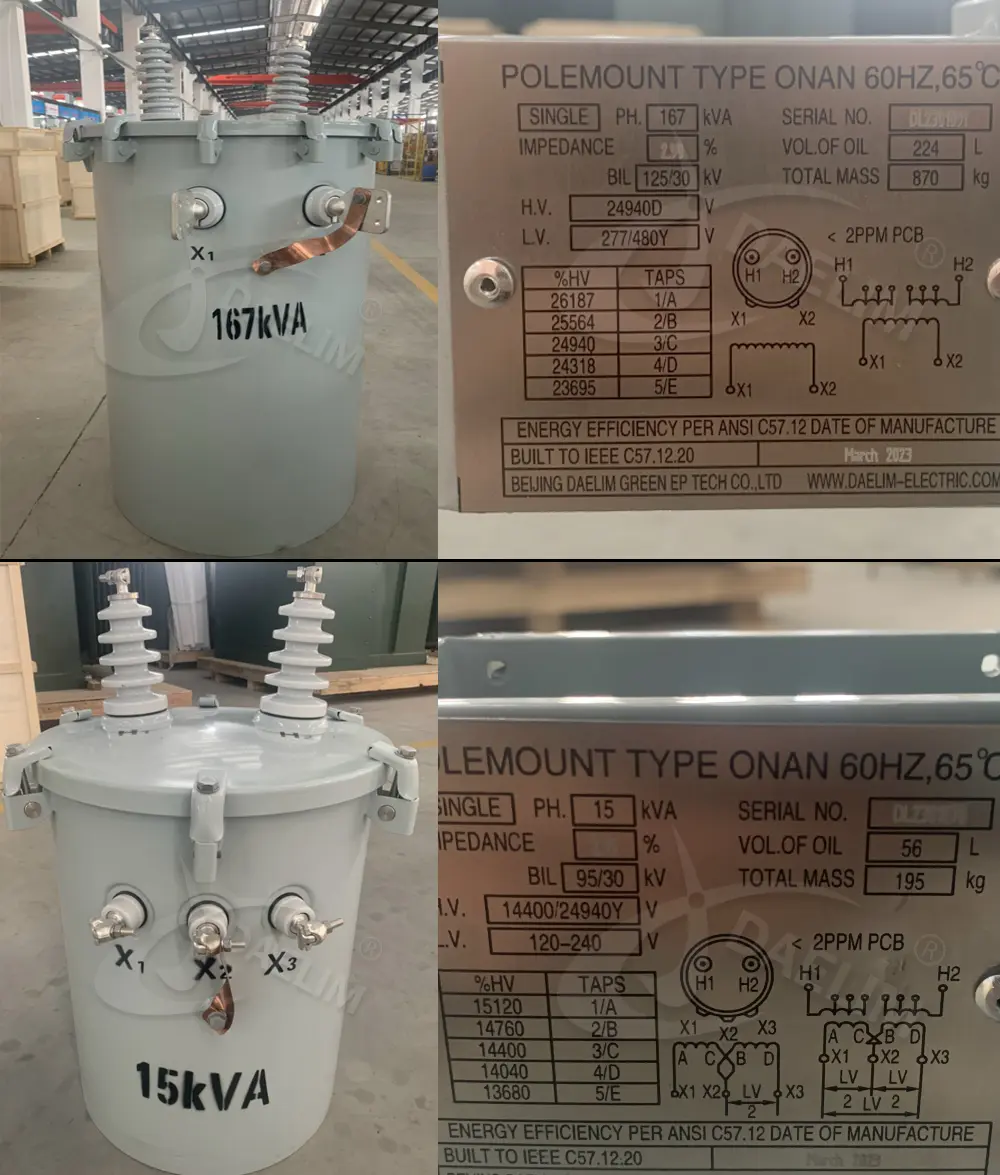
These are some of the kinds of overhead transformer connections, specifically for 3 phase power systems.
- Star-Star
- Delta-Delta
- Wye-Delta or Star-Delta
- Delta-Wye or Delta-Star
Star-Star (Y-Y)
The star configuration is the typical style of overhead transformer connections that are highly utilized for their size and capacity.
Because the phase voltage is just a third of the line voltage, the star arrangement calls for a significantly lower number of turns to be mainly used for each phase.
The only way to use this kind of overhead transformer connections
is if the weight is evenly spread out.
Delta-Delta
In the case of low-voltage transformers, delta overhead transformer connections are typically applied.
The ratio of the transformer's primary voltage to its secondary voltage is the same as the ratio of the two lines' voltages.
Both balanced and unbalanced loads are usually supported by these overhead transformer connections.
If one of the transformers fails, the system can still operate, although at reduced capacity.
Wye-Delta or Star-Delta
The connections for the primary coil are star connections, while the connections for the secondary coil are deltas.
This is the substation at the end of the transmission line, which is where the connections for the overhead transformer are mainly located.
Delta-Wye or Delta-Star
A star connection is typically used to ground the primary cable, while a delta connection is mainly utilized for the secondary cable.
In this type of overhead transformer connections, three-phase, four-wire systems can be highly utilized.
An initial transformer connection is typical for a transmission line.
About three times as much energy is necessary to change the voltage on the second line as on the primary line.
Learn more about Transformer connections
What Is The Primary Purpose Of Overhead Transformer Connections?
The principal function of overhead transformer connections is to protect the phase conductors from direct lightning strikes in areas where this is a problem, hence increasing reliability.
For the system to be effectively grounded, the ground wires must also provide a low impedance path back to the overhead distribution transformer.
This is true if and only if the ratio of the impedance of the zero sequences to the impedance of the positive sequence is less than three.
The insulation can be generally lowered if the system is properly grounded.
Since less insulation means less money spent on the line (and the system), this is a win-win.
As a result of reduced insulating costs, savings can be highly accumulated over time, which leads to structures that are smaller, lighter, and require less land.
Do All Countries Use Overhead Distribution Transformer?
Overhead distribution transformer typically runs along poles in older communities and rural regions.
These single phase overhead distribution transformers and 3 phase overhead transformer supplies power to anywhere from one to several houses.
The most popular solution is likely to be a compromise strategy in which high voltage distribution is highly carried out by running wires along poles situated on highways.
On the other hand, many of today's cities have buried their transmission lines and distribution lines to the point that they are fully underground.
To more efficiently deliver services to residents, it is common practice in major cities to excavate underground passageways and construct tunnels or ducts. This is done to improve the efficiency of the operation as a whole. So pad mounted transformer is widely used.
Daelim Is One of The Leading Supplier of Overhead Transformers
Daelim is a leading manufacturer of overhead distribution transformers used by different countries across the world. Daelim overhead transformer with UL/cUL, CSA, and CESI certificates.
Overhead transformers are an integral part of any distribution system, and Daelim has a wide variety to choose from.
The company's overhead distribution transformer can operate in either a single- or three-phase configuration.
When it comes to mechanical, thermal, and electrical performance, the Daelim core-coil design is highly unrivaled.
In addition to that, Daelim is a great spot to start shopping for both a single-phase and 3 phase overhead transformer. This will make it possible for you to obtain a transformer device that is dependable and of high quality and that is highly tailored to your requirements.
Related Products
Related Article
Single Phase Pole Mounted Transformer Project, Canada
Used in Saskatoon, Canada, 2019. We provided single phase transformers of 2.4kv, 7.,2kv, 13.8kv and 14.4kv. They are used for remote village net work.
Basic knowledge about telephone pole transformer
Beijing Daelim is a professional manufacturer and seller of telephone pole transformers, with more than ten years of experience in transformer production and export. Transformers manufactured by Daelim conform to IEEE, CSA, UL, and many other international standards.
The Ultimate Guide to Pole Mounted Transformers
Pole-mounted transformers are those generally used by utilities that are highly positioned at wire height on a wooden or concrete electrical service pole. This type of electricity transformer is mainly suspended on poles in an outdoor setting. These transformers are vital to the delivery of power to residential areas. Daelim offers the best possible quality, and we are highly known as one of the most successful pole-mounted transformer manufacturers across the globe.


